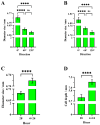Use of Relay Method for Enhancing Comb Construction by Apis cerana cerana Utilizing Apis mellifera ligustica
- PMID: 39859633
- PMCID: PMC11766157
- DOI: 10.3390/insects16010052
Use of Relay Method for Enhancing Comb Construction by Apis cerana cerana Utilizing Apis mellifera ligustica
Abstract
Italian honey bees (IHBs, Apis mellifera ligustica) exhibit superior comb-building abilities compared with Chinese honey bees (CHBs, Apis cerana cerana), which often fail to fully utilize wax foundations, resulting in incomplete comb structures. The present study aimed to accelerate comb construction in CHB colonies using IHBs. In the experiment, IHB colonies, each with approximately 42,000 adult workers, required over four hours to construct a semi-drawn comb on CHB wax foundations. These semi-drawn combs were then transferred to experimental CHB colonies, where they were left to complete the comb-building process for an additional 24 h (4 + 24 h relay). In contrast, control CHB colonies were allowed to build combs on fresh CHB wax foundations for 28 h. The results showed that the combs built by CHBs in 28 h, those built by IHBs in 4 h, and the 4 + 24 h relay combs all shared a foundation size of 41.7 cm × 19.7 cm, with average thicknesses of 10.40 mm, 5.60 mm, and 12.20 mm, respectively. The average percentage of cells built in the 4 + 24 h relay combs was significantly higher than that in the 28 h combs. Additionally, cells in the relay combs were significantly larger and deeper than those in the combs built solely by CHBs. Although these findings prove that utilizing IHB colonies to form a base structure can enhance the efficiency of comb construction in CHB colonies, further research is needed to confirm the effects of 4 + 24 h operation on brood rearing and worker bee size.
Keywords: Apis cerana cerana; Apis mellifera ligustica; comb cell; relay construct of comb.
Conflict of interest statement
The authors declare no conflicts of interest.
Figures










References
-
- Hepburn H.R., Pirk C.W.W., Duangphakdee O. Honeybee Nests. Springer; Berlin/Heidelberg, Germany: 2014.
-
- Hepburn H.R., Radloff S.E. Honeybees of Asia. Springer; Berlin/Heidelberg, Germany: 2011.
-
- Oldroyd B.P., Wongsiri S. Asian Honey Bees: Biology, Conservation, and Human Interactions. Harvard University Press; Cambridge, UK: 2006.
-
- Michener C.D. The Bees of the World. Johns Hopkins University Press; Baltimore, MD, USA: 2007.
-
- Winston M.L. The Biology of the Honey Bee. Harvard University Press; Cambridge, UK: 1987.
Grants and funding
- 32060241/National Natural Science Foundation of China
- 31572339/National Natural Science Foundation of China
- CARS-44-KXJ13/China Agriculture Research System of the Ministry of Finance and the Ministry of Agriculture and Rural Affairs
- No. 2018HB041/Reserve Talents Training Program for Young and Middle-aged Academic and Technical Leaders in Yunnan
LinkOut - more resources
Full Text Sources

